

 Typical. Guessing right again…?
Typical. Guessing right again…?
They are easily counted, the times I have called a wine “typical” during the past year.
But what is typical?
Everyone who has attended a wine course has learned typical aromas for some of the most popular grape varieties: cedar and black currants for Cabernet Sauvignon, tar and charcuterie for Syrah, raspberry and strawberry for Pinot Noir, cherries for Sangiovese, petroleum for Riesling etc. But even if it sometimes is the case it is easy to be mistaken.
I don’t want to think about how many times I have mistaken a Bordeaux for a Burgundy (or vice versa) when tasting blind, just to take a classic example. Don’t believe he who says that it is easy or that he has never mixed them up. Rather, find yourself a new friend, since this one is not trustworthy.
The bitter truth is that few grape varieties have such clear characteristics that they shine through other influences like climate, vinification, oak ageing, etc.
We also have a large number of wines in the world that are blended with no dominating grape. And the New World’s warm climate completely changed the perception of the classic grape varieties. Today we also have wines with no or very little sulphur, which often completely obliterates the grape characteristics (as well as the sense of origin). The influence of oak on the wine is well known. When people describe a Tempranillo they actually often describe a Rioja.
Many grape varieties that have become popular in recent years, such as Grenache, Carignan, Viognier, Vermentino and others, have characters that are somewhat vague and easily influenced by terroir and by the the philosophy of the producer.
It’s always fun, though, to recognize a wine and it’s still possible, sometimes. But it is often another type of recognition. Instead of the grape, you recognize the structure, the freshness, the tannins, the texture, the body, the drinkability, the elegance. And it is rather through these characteristics that you recognize the quality of a wine.
In any case, when push comes to shove, what is important is not to guess correctly. It is, in fact, not very important. What is important is the joy and pleasure that you get out of what you drink. And that it gives some something to discuss with your dinner guests.
In this Brief you can find plenty to read. Christmas gift tips. News on organic wines. Portuguese grapes. Champagne. Bordeaux…
And most important of all, you will find all the info you need on our wine tours. We hope to see you on one of those next year.
Britt & Per
PS: Recommend to your friends to read the Brief !
– – – – –
What’s on at BKWine Tours
Winter 2019
- Chile-Argentina, January 20 – February 4, 2019
- South Africa, February 16-24, 2019
- New Zealand, March 11-26, 2019
- Bordeaux, April 10-14, 2019
Autumn
- New Zealand, November 20 – December 5, 2019
- More coming
For more information please contact us on email or on phone (we’re on French time), or go to our wine travel site on www.bkwinetours.com!
We also make custom designed wine tours – on-demand tours for you and a group of friends, for your company (maybe to scout new winegrowers?), for a special event… We can combine winery visits and wine touring with other activities: gastronomic workshops, visit to an oyster farm, truffles hunting, cheese making, and more. More info on the custom designed and bespoke BKWine wine tours and travel here!
Read our book(s)
We have written several wine books, nine at the last count. One of them has been translated to English; the others are (so far) only available in Swedish. This is the one that is available in English: Biodynamic, Organic and Natural Winemaking, Sustainable Viticulture and Viniculture
All our books are on wine, but on different subjects: wines of the Languedoc, wine growing and wine making, the wines of France, Tuscany, Bordeaux, Piedmont, Burgundy, Champagne. Several have won prestigeous prizes and awards. Read more on our wine books.
From the World of Wine
In Brief
In short, news and stuff from the world of wine.
Henkell, a bubbly giant grows bigger
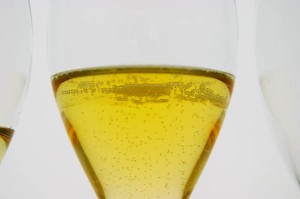 Henkell Trocken is one of the world’s most famous sparkling wines. The German company Henkell & Co is also the largest producer in the world of sparkling wines since the purchase of Spanish Freixenet in March 2018. Henkell now accounts for 8% of the world market for bubbles and is aiming for 10%. In addition to its production of sekt and cava, Henkell also owns the prosecco producer Mionetto and Champagnes Alfred Gratien.
Henkell Trocken is one of the world’s most famous sparkling wines. The German company Henkell & Co is also the largest producer in the world of sparkling wines since the purchase of Spanish Freixenet in March 2018. Henkell now accounts for 8% of the world market for bubbles and is aiming for 10%. In addition to its production of sekt and cava, Henkell also owns the prosecco producer Mionetto and Champagnes Alfred Gratien.
Henckel Trocken is not dry although it certainly sounds like it. No matter the language, it’s the common EU rules that apply (no doubt based on old customs from Champagne). Sec, dry or trocken, in bubble language, all mean – rather confusing – that the wines have between 17 and 32 grams of sugar per litre. More like semi-sweet. There is also a less known Henkell Brut. More dry.Read more about the giant company Henkell & Co on winemag
Star Wine List recommends restaurants with good wine lists
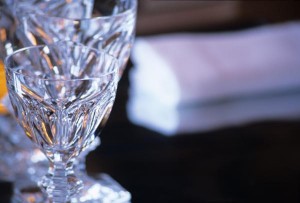 Star Wine List is a digital guide to wine bars and wine restaurants in different cities. Currently, the guide covers Stockholm, Gothenburg, Uppsala and several other locations in Sweden as well as Oslo, Toronto and London. And more cities are coming soon. Krister Bengtsson is the man behind this excellent tool.
Star Wine List is a digital guide to wine bars and wine restaurants in different cities. Currently, the guide covers Stockholm, Gothenburg, Uppsala and several other locations in Sweden as well as Oslo, Toronto and London. And more cities are coming soon. Krister Bengtsson is the man behind this excellent tool.
Read about great restaurants and wine bars but also more specific recommendations such as where to drink natural wines, in which restaurants you find the biggest number of Riesling wines or which restaurants are especially strong on Bordeaux. You can even read online some of the restaurants’ entire wine lists. You can find it here: StarWineList.
The perfect Christmas presents for those who love food, wine and travel
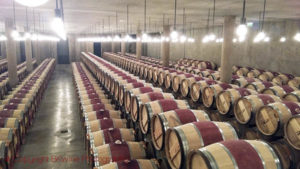 We have, of course, also to give you some suggestions of what must be the perfect Christmas presents for those who like food and wine and travel, now that Christmas is approaching fast. We have two different suggestions for you.
We have, of course, also to give you some suggestions of what must be the perfect Christmas presents for those who like food and wine and travel, now that Christmas is approaching fast. We have two different suggestions for you.
The really, really nice Christmas gift is of course a wine tour to one of the world’s wonderful wine regions. Perhaps a last-minute trip to Chile-Argentina in January? Or to some of the classic wine regions in Europe. Or why not New Zealand? Here you can find all information you will need the world’s best wine tours. We can of course also make a gift card if you wish.
The second gift recommendations is one of all the ten (yes, 10!) wine books we have written. Unfortunately, only one of them has been translated to English. But if someone is interested in organic wines, this will be the perfect gift, the ultimate guide to what organic wine is.
Of course, these gifts are perfect, even if you give them to yourself!
EU lowers the limit for copper spray in the vineyards to 4 kg
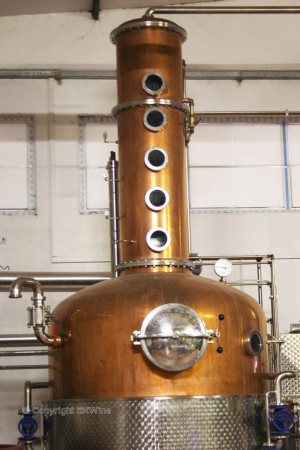 The European Commission has now voted on the future of copper in European agriculture. On November 27, the decision was made to lower the limit to 4 kilograms of copper per year and per hectare counted as an average over a 7-year period (in other words, 28 kg in 7 years). This 4 kilos average of copper per year and per hectare compares to 6 kilograms at present (or more precisely 30 kilos over a period of 5 years). Lower dose but longer time period. The new rules will enter into force in February 2019.
The European Commission has now voted on the future of copper in European agriculture. On November 27, the decision was made to lower the limit to 4 kilograms of copper per year and per hectare counted as an average over a 7-year period (in other words, 28 kg in 7 years). This 4 kilos average of copper per year and per hectare compares to 6 kilograms at present (or more precisely 30 kilos over a period of 5 years). Lower dose but longer time period. The new rules will enter into force in February 2019.
Some seem satisfied with the decision and are pleased that copper has not been completely banned, while others believe that it is a bad decision that has been taken and that it will knock out maybe 20% of the organic winegrowers in France. Nevertheless many growers already use less copper, e.g. biodynamics who has a limit of 3 kg. How much is needed is very dependent on weather conditions.
Wine producers in several parts of France were hit hard in 2018 by mildiou, a fungal disease against which the organic growers use copper. Growers that are not organic can use other synthetic products. Read more: vitisphere
Read: Want to know more about organic wine? Read BKWine’s book Biodynamic, Organic and Natural Winemaking.
A new machine harvester for small vineyards
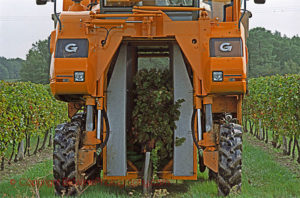 When some people think about machine harvesting, they often imagine big monsters that brutalize the vineyard. It is true that harvesting machines are often big machines, but they can be quite gentle to both grapes and vines. And soon there will be on the market a tiny harvesting machine, suitable for the small producer and for high-density vineyards.
When some people think about machine harvesting, they often imagine big monsters that brutalize the vineyard. It is true that harvesting machines are often big machines, but they can be quite gentle to both grapes and vines. And soon there will be on the market a tiny harvesting machine, suitable for the small producer and for high-density vineyards.
This new little harvesting machine weighs only 1.5 tonnes, flyweight for tractors, and can handle slopes of up to 30% inclination. The small weight is an advantage since it doesn’t compact the soil, otherwise an environmental problem. The machine is also energy-efficient. The speed is 2-3 km per hour and it can easily harvest 2.5 hectares in one day. You can see the small harvesting machine here mon-viti
Is hand harvest better than machine harvest? Read about the facts and the myths on manual vs mechanical harvest here.
Old vines in South Africa, rediscovered and rescued
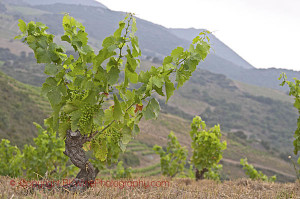 Older vines give more character to the wine, says Rosa Kruger, a well-known South African viticulturist. She is behind a project called South Africa’s Old Vines Project, which aims at finding old vineyards, vineyards that have often been abandoned. The idea with the project is to give a new life to these old vines. A vine in South Africa is considered to be old at the age of 35. Only 3.4% of South Africa’s vineyard surface has reached this age or more. Just over half of it is Chenin blanc.
Older vines give more character to the wine, says Rosa Kruger, a well-known South African viticulturist. She is behind a project called South Africa’s Old Vines Project, which aims at finding old vineyards, vineyards that have often been abandoned. The idea with the project is to give a new life to these old vines. A vine in South Africa is considered to be old at the age of 35. Only 3.4% of South Africa’s vineyard surface has reached this age or more. Just over half of it is Chenin blanc.
These old vineyards often belong to growers who are part of a cooperative. They must be persuaded to keep the old vines and not pull them up and to either make an “Old Vine” cuvee themselves that they can sell more expensive or to let a young and ambitious winemaker lease the vineyard and make his own wine from the grapes. In the long run, Rosa Kruger hopes that all vines planted in South Africa will be virus-free vines and thus hopefully live longer and produce better wines for the future. Read more about this interesting Old Vines project in South Africa here the-buyer.net
Travel: Travel to South Africa’s wine lands with on a wine tour with BKWine.
Portugal’s most planted grape varieties, the top-ten list
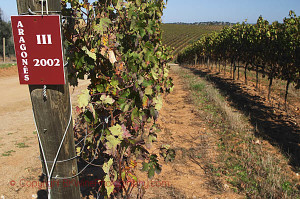 Portugal is a wonderful wine country in many ways. Not least because it is unrelentingly focusing on Iberian grape varieties. The only French grape that is included in the top-10 list is Syrah, and it is in the 10th place. There is an immense variety of grapes. The 10 most grown only account for 55% of the entire vine surface of the country.
Portugal is a wonderful wine country in many ways. Not least because it is unrelentingly focusing on Iberian grape varieties. The only French grape that is included in the top-10 list is Syrah, and it is in the 10th place. There is an immense variety of grapes. The 10 most grown only account for 55% of the entire vine surface of the country.
The most planted grape varieties in Portugal, in hectares, as well as upward or downward trends.
- Tempranillo/Tinta Roriz/Aragonese, red, 18,000 ha (up)
- Touriga Franca, red, 15,000 ha (up)
- Castelão, red, 13,000 (down)
- Fernão Pires, white 13,000 ha (down)
- Touriga Nacional, red, 12,000 ha (up)
- Trincadeira, red 11 000 ha (down)
- Baga, red, 7,000 ha (down)
- Síria / Roupeiro, white, 7,000 ha (down)
- Arinto, white, 6,000 ha (up)
- Syrah, red, 6,000 ha (up)
- Other grape varieties, 91 000 ha
- Total area 199 000 hectares
Source OIV
Travel: Travel with BKWine to the vineyards of Portugal, the Douro Valley.
France 2018: a big harvest, with Languedoc or Bordeaux at the top
France in general did a good harvest in 2018, both in volume and in quality. The Ministry of Agriculture has just published figures for the different regions. Total production was 46.6 million hectolitres, which is 26% higher than 2017, a year affected by both frost and drought that dramatically reduced the size of the harvest.
In 2018 the AOP wines (appellation d’origine protegée, previously AOC) account for 48% of the production. 26% are IGP wines (indication geografique protegée, previously “vin de pays”), 18% is wine for distillation (Cognac, Armagnac etc) and 6% is vin de france (formerly “vin de table”). Bordeaux has the largest AOP production with 5.2 million hectolitres. Champagne is second with 3.3 million hectolitres, Provence third with 3.1 million hl followed by Languedoc-Roussillon with 2.7 million hl, the Loire Valley and Burgundy/Beaujolais with 2.5 million hl each, the Southwest with 1.3 million hl and Alsace with 1.1 million hl. Looking at the production of all types of wines, AOP + IGP + vin de france, Languedoc-Roussillon is the number one region with 12.6 million hl. Source: agreste
Alsace is leader in Europe on biodynamics (and organic?)
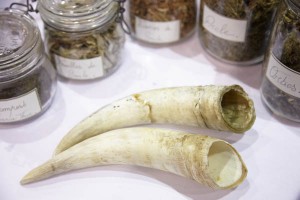 Alsace is the number one biodynamic wine region in Europe. 880 hectares are certified biodynamic. This means that an impressive 5.6% of all Alsace vineyards are biodynamic, a record in Europe. Around 70 growers are certified either with the international certification association Demeter or the French association Biodyvin. All of these producers are also organically certified, which is a requirement both with Demeter and with Biodyvin.
Alsace is the number one biodynamic wine region in Europe. 880 hectares are certified biodynamic. This means that an impressive 5.6% of all Alsace vineyards are biodynamic, a record in Europe. Around 70 growers are certified either with the international certification association Demeter or the French association Biodyvin. All of these producers are also organically certified, which is a requirement both with Demeter and with Biodyvin.
2550 hectares are certified organic in Alsace. This is 16.5% of the Alsace vineyards, also a high figure compared to most other wine regions in Europe.
There are many positive aspects about biodynamic viticulture (as well as some odd ones), not least the fact that the biodynamic wine producers use much less copper spray compared to most organic growers. The limit for biodynamic growers is set at only 3 kilograms of copper per hectare and year, which is half of what is currently allowed in the organic rules. Read more: Vitisphere
Features
Features that we have published during the past month, with lots of reading for you.
A daring tasting with base wines from Palmer & Co’s Blanc de Noirs
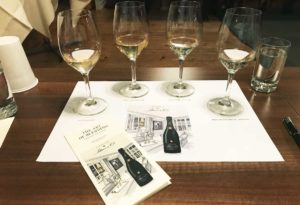 When you produce champagne you always start by making a still wine without bubbles. This “base wine” is bottled with some yeast and sugar, and thus the bubbles are made. Few people get the chance to taste these still base wines, for good reasons. They can be difficult to understand and appreciate because they usually have an exceptionally high acidity. The acidity is needed to give freshness and elegance in the finished champagne. But Palmer & Co had the audacity to present their still base wines to a small group of journalists, to give a different perspective on their champagne.
When you produce champagne you always start by making a still wine without bubbles. This “base wine” is bottled with some yeast and sugar, and thus the bubbles are made. Few people get the chance to taste these still base wines, for good reasons. They can be difficult to understand and appreciate because they usually have an exceptionally high acidity. The acidity is needed to give freshness and elegance in the finished champagne. But Palmer & Co had the audacity to present their still base wines to a small group of journalists, to give a different perspective on their champagne.
BKWine Magazine’s Sven-Olof Johansson was there and tells the story about the experience: Palmer & Co Blanc de Noirs. Let the dark side take over.
Travel: Travel to Champagne on a wine tour with BKWine.
Discover the elegant nebbiolos from Barbaresco
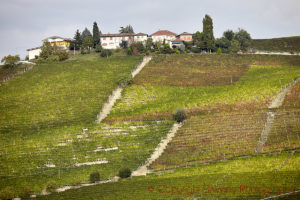 Barbaresco was recently named “Wine Region of the Year” by the wine tasting association Munskänkarna. The region has perhaps languished in the shadow of the more famous neighbour Barolo, but that is about to change. “Two of Italy´s most prestigious wines are the Piedmontese stars Barolo and Barbaresco. Both made from 100% of the autochthonous Piedmont grape variety Nebbiolo. It is easily recognized by its light colour, high tannins and perfumed aromas, but the two wines have some notable differences.”
Barbaresco was recently named “Wine Region of the Year” by the wine tasting association Munskänkarna. The region has perhaps languished in the shadow of the more famous neighbour Barolo, but that is about to change. “Two of Italy´s most prestigious wines are the Piedmontese stars Barolo and Barbaresco. Both made from 100% of the autochthonous Piedmont grape variety Nebbiolo. It is easily recognized by its light colour, high tannins and perfumed aromas, but the two wines have some notable differences.”
Read more in Sara Nässén’s article on BKWine Magazine: Meet the Queen of Wines, Barbaresco.
One of Sicily’s greats: Tasca d’Almerita
Like a big green oasis she rises, Tenuta Regaleali. After driving on a winding, rough road and thanking a higher power that I do not suffer from road-sickness, we finally get up on the crest. There, we get a mighty view. Suddenly the road is well-kept and lined with eucalyptus trees, while rolling vineyards extend towards the horizon. When we arrive at the houses, it feels like walking into a movie. The typical stone houses have beautifully painted blue doors surrounded by colourful flowers. A magnificent magnolia in the courtyard and a lush kitchen garden. But it’s not a movie. It is very real. It is Tenuta Regaleali, run by the Tasca d’Almerita family since eight generations.
Read Åsa Johansson’s article on BKWine Magazine: Taking Sicily into the future with Tasca d’Almerita.
A prosecco worth discovering, Villa di Maser | Britt on Forbes
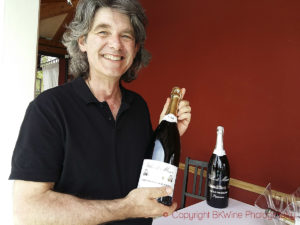 “Prosecco is producing more and more bottles. This year they will pass 500 million. People can’t seem to get enough. The yields for the simplest Proseccos are sky high, making the resulting wine sometimes a bit thin and tasteless. What can you expect with excessive yields? But there are different proseccos. There are excellent proseccos, if you know where to look. If you want to have a decent Prosecco in your glass, you should choose carefully.”
“Prosecco is producing more and more bottles. This year they will pass 500 million. People can’t seem to get enough. The yields for the simplest Proseccos are sky high, making the resulting wine sometimes a bit thin and tasteless. What can you expect with excessive yields? But there are different proseccos. There are excellent proseccos, if you know where to look. If you want to have a decent Prosecco in your glass, you should choose carefully.”
Read more on this in Britt’s article on BKWine Magazine, originally published on Forbes: Ambitious prosecco and curious whites and reds from Villa di Maser | Britt on Forbes.
Discover the wines in Armenia in The Wine Cube
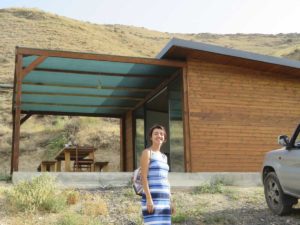 Armenia is a little-known wine country although it is believed to be one of the oldest wine producing regions, with a history going back more than 6000 years. Recently, a new concept was launched to promote wine tourism and to make the wine regions better known both with locals and international visitors: The Wine Cube.
Armenia is a little-known wine country although it is believed to be one of the oldest wine producing regions, with a history going back more than 6000 years. Recently, a new concept was launched to promote wine tourism and to make the wine regions better known both with locals and international visitors: The Wine Cube.
With this article, we introduce BKWine Magazine’s new guest contributor, Marina Mirzabekian who gives us a first glimpse into Armenia wine: The Wine Cube can help Armenia develop its wine tourism.
Time to rediscover Beaujolais Nouveau? | Britt on Forbes
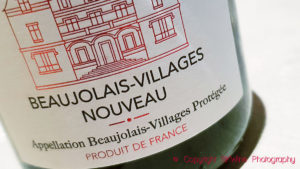 Beaujolais has had a few hard years but it is now back in fashion. Today, the third Thursday of November, is the release of the new vintage of Beaujolais Nouveau. Now representing approximately 30 % of the total Beaujolais production, the wine producers put a lot of effort into their Nouveau wines. The quality has improved tremendously. And people all over the world love them, especially the Japanese. Beaujolais has actually always been a favourite of mine. The easy drinking, fruity style and the absence of oak ageing make it a very appealing wine especially for everyday drinking.
Beaujolais has had a few hard years but it is now back in fashion. Today, the third Thursday of November, is the release of the new vintage of Beaujolais Nouveau. Now representing approximately 30 % of the total Beaujolais production, the wine producers put a lot of effort into their Nouveau wines. The quality has improved tremendously. And people all over the world love them, especially the Japanese. Beaujolais has actually always been a favourite of mine. The easy drinking, fruity style and the absence of oak ageing make it a very appealing wine especially for everyday drinking.
Read more about Britt’s article on BKWine Magazine, originally published on Forbes: Beaujolais is back in fashion | Britt on Forbes.
A Successful Wine And Marketing Strategy For Bordeaux, Les Côtes | Per on Forbes
“A little bit over ten years ago a group of winemakers in Bordeaux decided to band together to be more effective in marketing their wines. They created Les Côtes de Bordeaux, or simply Les Côtes. It is one of the rare occasions when French appellations have been simplified to make it easier for the consumer, rather than complexified. I can think of only one other occasion where that has happened (read through to the end and I’ll explain that too).”
Read more on this in Per’s article on BKWine Magazine, originally published on Forbes: A success story: Les Cotes de Bordeaux | Per on Forbes.
Travel: Travel to Bordeaux on a wine tour with BKWine.
Wine tours
Some information about current and future wine tours with BKWine.
Last Minute: Give in to the temptation, join us on a wine tour to Chile and Argentina
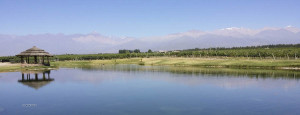 We have had a cancellation so we have two seats left on the fantastic wine tour to Chile and Argentina. It is a journey that of course contains a lot of wine and gastronomy. We visit some of the best producers in Mendoza and in the most important wine regions in Chile. But the tour includes much, much more. It kicks-off in Buenos Aires, a magnificent metropolis, a bustling city with a European atmosphere. The city of Mendoza is a big contrast, rural and very Latin American. The road-trip across the Andes, by bus up to 3000 meters (10,000 ft), is worth a trip just on its own. A very special experience.
We have had a cancellation so we have two seats left on the fantastic wine tour to Chile and Argentina. It is a journey that of course contains a lot of wine and gastronomy. We visit some of the best producers in Mendoza and in the most important wine regions in Chile. But the tour includes much, much more. It kicks-off in Buenos Aires, a magnificent metropolis, a bustling city with a European atmosphere. The city of Mendoza is a big contrast, rural and very Latin American. The road-trip across the Andes, by bus up to 3000 meters (10,000 ft), is worth a trip just on its own. A very special experience.
Then there will be Santiago, Valparaiso, and a lot more. Including a wonderfully charming hacianeda-style hotel in the Santa Cruz, pisco sours included. Go for it and join us in January! More on the wine tour to Chile and Argentina January 21 to February 3, 2019.
Bordeaux: great wines, elegant city, fantastic gastronomy | wine tour
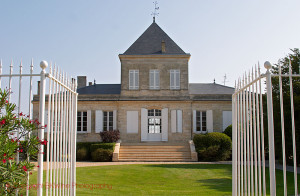 Bordeaux is not only France’s most well-known wine region but also France’s most elegant city. We stay here during our Bordeaux tour in April. From Bordeaux you can easily reach the chateaux of Médoc, Saint Emilion, Pessac-Léognan and so on. In April the vines have just started to grow again and we will have plenty of opportunity to discuss the important work in the vineyard. We will see beautiful and even spectacular cellars and we will taste new and old vintages of exclusive Bordeaux wines. Our magnificent chateaux lunches are famous by now. Every wine lover must go to Bordeaux once, and the best way to get an insight into its wine is on this tour.
Bordeaux is not only France’s most well-known wine region but also France’s most elegant city. We stay here during our Bordeaux tour in April. From Bordeaux you can easily reach the chateaux of Médoc, Saint Emilion, Pessac-Léognan and so on. In April the vines have just started to grow again and we will have plenty of opportunity to discuss the important work in the vineyard. We will see beautiful and even spectacular cellars and we will taste new and old vintages of exclusive Bordeaux wines. Our magnificent chateaux lunches are famous by now. Every wine lover must go to Bordeaux once, and the best way to get an insight into its wine is on this tour.
Read more about the Bordeaux wine tour 10-14 April 2019.
Wine tours with BKWine autumn-fall 2019
We are in the process of finalising the autumn-fall wine tour program for 2019. It will be a short selection of a few of the world’s best wine tour destinations that you can choose from. Here is the preliminary list of wine regions and dates for the autumn 2019:
- Champagne, September 11-15
- Bordeaux, October 2-6
More information coming soon on BKWineTours.
New Zealand, wine experiences beyond the usual | wine tour
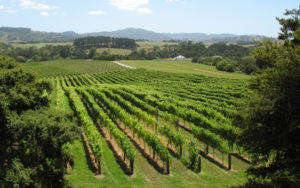 New Zealand is a different New World country. The climate is cooler and the wines often feel more European in style, even though the country has developed its very own style, which is often easily recognized. The white grapes are important but Pinot Noir and even Bordeaux grapes are more and more common. During our tour in this amazing country, we visit all the important wine regions and we will taste all the different wine styles that are available today in New Zealand.
New Zealand is a different New World country. The climate is cooler and the wines often feel more European in style, even though the country has developed its very own style, which is often easily recognized. The white grapes are important but Pinot Noir and even Bordeaux grapes are more and more common. During our tour in this amazing country, we visit all the important wine regions and we will taste all the different wine styles that are available today in New Zealand.
In addition, we will also devote some time to other things than wine tasting. We will see geysers and glaciers, and we will get to know the Maori culture. We travel by bus from Auckland on the North Island down to Queenstown on the South Island so that we will see a big part of the country and its amazing scenery. The tour to New Zealand is in March and November 2019. The March trip is fully booked. In November summer is just starting.
Book your wine tour to New Zealand now, an experience and an adventure! New Zealand wine tour, November 20 – December 5, 2019.
Don’t be an egoist! Share with your friends and other wine enthusiasts! Forward the Brief to your friends! Suggest that they sign up for a free subscription !
© Copyright BKWine








